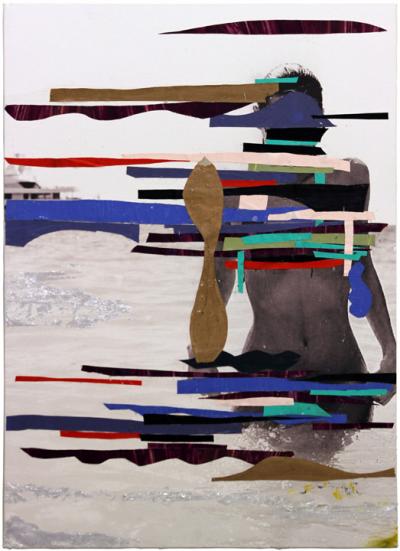Enoc Perez’s ‘Summer Job’

While some of us were basking in the sun or sitting in bumper-to-bumper traffic to get to the next much-hyped event, Enoc Perez was hard at work in his East Hampton studio on the pieces presented in “Summer Job” at Harper’s Books in East Hampton.
The frothy riff touches on social media, appropriation, modern art, and, if you’re feeling academic in these lazy dog days, Lacanian notions and related theories of the subject and object of the gaze in art.
This series has its roots in the artist’s earlier and loftier form of appropriation, namely using elements of Picasso’s compositions in combination with his exploration of the painted nude or on their own. Now, he has taken images from Instagram of minimally dressed women, from amateur selfies to more professional photos, and added collage and his own painted marks. The applied shapes resemble some of Picasso’s own abstracted female forms, the cutouts of Matisse, and even, perhaps with this summer’s Gagosian show of Marcel Duchamp in mind, a group of “Stoppages” in one work.
Of course, Duchamp’s Dada explorations of collage and readymades were seminal and helped define the form. His rebranding of Mona Lisa postcards and popular advertisements with his own predilection for puns, the off-color joke, and sexual innuendo inspired generations to follow.
One of the first works in the show, a superimposed “Desmoiselles d’Avignon” on a poster for the Harmony Korine film “Spring Breakers,” serves as a bridge between this higher form of art play and a film that used the nominally clad “Girls Gone Wild” culture as a plot device. The mash-up of women behaving outside of socially acceptable norms then and now is punchy in a way that is more powerful than might immediately be surmised. Its color bath of bloody red suggests violence, menace, and carnal love.
That crossover work is the heaviest in the show in terms of art historical heft and impact. The others are more playful, coming from a small and more informal book the artist used to plan the series before he turned to the larger works on paper and canvas displayed in the gallery. Yet, it colors those pieces, making them more fraught than their romping beach-y revelry might otherwise suggest.
Most of the canvas transfers and works on paper were worked out previously, with the cutout shapes predetermined. One inkjet piece on photographic paper is more freestyle, using a few small shapes but taking hints of paint that are found on some of the other works and applying them expressively in wide swathes around and over the figure. Although the splats, splashes, squiggles, and the above-referenced shapes by artists from a prior century are engaging, the wash of paint gives the work a deeper, more substantial feeling. It seems like a natural progression and is reductive in its expansion over the composition, allowing only glimpses of what the artist wants to be seen.
The cutout shapes may function as a censor’s blue dots or pixelated screens, thwarting our ability to see the original image in its entirety and thereby making it all the more attention-grabbing, casting viewers into the role of voyeur. Not only are the body’s parts or its entirety obscured, but the faces are also always partially or wholly hidden, raising issues of objectification and a hint of malfeasance, the identities hidden to protect the innocent.
The collaged bits make it into a happy game, playful colors and forms replacing a need for more visual information. With the paint, the artist reminds his audience who is in control. Rather than a frisky gambit, we see a more serious attempt to obscure and confound and a more direct homage to Richard Prince, another one of the artist’s predecessors and inspirations for this series.
Since all of the works are dated from this year and were completed this summer, the question becomes: Is this where the series came from, or is it where it is going? In his earlier series involving transfers of oil stick drawings of buildings onto canvas, the brushwork he used to embellish them came later on. It would seem that this could be the same case here and a more suitable style for the cooler and more serious months ahead.
The show will remain on view through Columbus Day.
